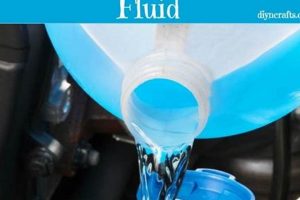The practice of individuals performing automotive lubricant replacement independently is a task undertaken by vehicle owners to maintain engine health. This procedure typically involves draining used oil from the engine, replacing the oil filter, and refilling with the appropriate grade and quantity of new oil as specified by the vehicle manufacturer. Such self-servicing represents a direct approach to automotive maintenance.
Engaging in this maintenance task can provide cost savings compared to professional service, foster a deeper understanding of vehicle mechanics, and offer flexibility in scheduling maintenance. Historically, performing vehicle maintenance at home was a common practice, reflecting a culture of self-reliance and mechanical aptitude. This tradition continues to resonate with individuals seeking greater control over their vehicle upkeep.
The subsequent sections will delve into the tools and materials required for this undertaking, provide a step-by-step guide to the process, outline essential safety precautions, and address the responsible disposal of used oil and filters. Proper execution of this procedure is paramount for ensuring optimal engine performance and longevity.
DIY Oil Change
Proper execution of an automotive lubricant replacement is crucial for maintaining engine health and maximizing vehicle longevity. The following tips are designed to enhance the efficiency and safety of the process.
Tip 1: Consult the Vehicle’s Manual: Prior to commencing the procedure, it is imperative to consult the vehicle’s owner’s manual. This document specifies the correct oil type and quantity required for the engine, ensuring optimal performance and preventing potential damage.
Tip 2: Gather Required Tools and Materials: Ensure all necessary tools and materials are readily available before starting. This includes a wrench for the oil drain plug, an oil filter wrench, a new oil filter, the correct type and quantity of oil, a drain pan, gloves, and safety glasses. Having everything prepared streamlines the process and minimizes delays.
Tip 3: Warm the Engine Slightly: Running the engine for a brief period, approximately 2-3 minutes, warms the oil, allowing it to flow more freely and drain more completely. However, avoid overheating the engine, as hot oil can cause burns.
Tip 4: Properly Position the Vehicle: Use ramps or jack stands to elevate the vehicle safely. Ensure the vehicle is stable and secure before working underneath it. Never rely solely on a jack for support.
Tip 5: Pre-Lube the New Oil Filter: Before installing the new oil filter, apply a small amount of fresh oil to the rubber gasket. This creates a better seal and prevents the filter from sticking to the engine.
Tip 6: Tighten the Drain Plug to the Specified Torque: Consult the vehicle’s service manual for the correct torque specification for the oil drain plug. Over-tightening can damage the oil pan, while under-tightening can lead to leaks.
Tip 7: Use a Funnel When Adding New Oil: Employ a funnel to prevent spills when pouring new oil into the engine. Spills can be difficult to clean up and may damage engine components.
Tip 8: Check the Oil Level After Refilling: After adding the new oil, use the dipstick to verify that the oil level is within the recommended range. Add more oil as needed to reach the proper level. Avoid overfilling the engine.
By adhering to these guidelines, individuals can perform automotive lubricant replacement with greater confidence and effectiveness. Proper preparation, attention to detail, and adherence to safety precautions are paramount for a successful outcome.
The concluding section will address responsible disposal methods for used oil and filters, ensuring environmental stewardship and compliance with local regulations.
1. Correct Oil Selection
The efficacy of an independent automotive lubricant replacement is inextricably linked to the correct selection of engine oil. The chosen lubricant fundamentally dictates the protection afforded to the engine’s internal components. Utilizing an incorrect oil grade or specification can precipitate premature wear, reduced fuel efficiency, and potential engine failure. For example, employing a lower viscosity oil than specified for a high-performance engine may result in inadequate lubrication at elevated temperatures, leading to increased friction and accelerated wear. Conversely, using a higher viscosity oil in a modern, tightly-toleranced engine can impede proper oil flow, reducing fuel economy and potentially causing cold-start issues.
Vehicle manufacturers specify precise oil requirements based on engine design, operating conditions, and environmental factors. Adhering to these recommendations, typically found within the vehicle’s owner’s manual or on the oil filler cap, is crucial. Modern engines often require synthetic or semi-synthetic oils formulated with specific additives to enhance performance, reduce friction, and extend oil drain intervals. A practical illustration involves vehicles equipped with variable valve timing systems; these systems rely on precise oil pressure and flow to function correctly, making the use of the specified oil type critical. Substituting with a non-approved oil could impair system operation, resulting in reduced engine performance and potential diagnostic trouble codes.
In summary, correct lubricant selection is not merely a detail but a foundational element of any successful independent oil change. Failure to adhere to manufacturer specifications can negate any potential cost savings associated with self-servicing and potentially lead to substantial engine repair costs. Therefore, consulting the vehicle’s documentation and understanding the specific oil requirements are paramount before undertaking the procedure.
2. Essential Tool Availability
The successful execution of independent automotive lubricant replacement is contingent upon the availability of specific tools. The absence of any one critical instrument can impede progress, compromise safety, and potentially damage vehicle components. This interdependence is a direct cause-and-effect relationship: readily available, appropriate tools enable efficient and safe execution; conversely, a lack thereof directly hinders the process. For example, attempting to remove an oil filter without a dedicated oil filter wrench can lead to a damaged filter housing or, in extreme cases, injury to the individual. The availability of the correct tools transcends mere convenience; it is a prerequisite for achieving a successful outcome.
Consider the scenario of replacing the oil drain plug. A torque wrench is essential for tightening the plug to the manufacturer’s specified torque. Over-tightening can strip the threads of the oil pan, necessitating costly repairs. Under-tightening, conversely, can result in
oil leaks, leading to engine damage from insufficient lubrication. The presence and proper use of a torque wrench mitigate these risks. Similarly, a funnel is a seemingly simple tool, yet its absence can lead to oil spillage, creating a hazardous work environment and potentially damaging surrounding engine components. Adequate lighting, another often-overlooked component, is vital for clear visibility, ensuring accurate identification of components and leak detection.
In conclusion, access to the requisite tools is not merely advantageous; it is fundamentally intertwined with the viability and safety of performing automotive lubricant replacement independently. Careful consideration of the necessary tools, coupled with a commitment to their proper utilization, is essential for mitigating risks, ensuring a successful procedure, and realizing the intended benefits of self-servicing. Neglecting this aspect can transform a cost-saving endeavor into a source of mechanical and financial complications. Proper tool availability is key to a safe and efficient process.
3. Safe Vehicle Elevation
Automotive lubricant replacement performed by individuals necessitates elevating the vehicle to gain access to the oil drain plug and filter. This process introduces inherent risks that demand meticulous attention to safety protocols. Improper vehicle elevation is a direct precursor to potential injury and vehicle damage. The stability of the vehicle during the procedure is paramount, and any deviation from established safety standards can lead to catastrophic consequences. Examples include utilizing inadequate lifting equipment, failing to properly secure the vehicle with jack stands, or working on uneven surfaces. The practical significance of understanding and adhering to safe vehicle elevation techniques cannot be overstated; it is a fundamental element in the successful and injury-free execution of an independent oil change.
Practical application involves several key steps. First, selecting appropriate lifting equipment, such as a hydraulic jack with sufficient weight capacity, is crucial. Second, identifying designated lifting points on the vehicle’s frame or chassis, as specified in the owner’s manual, prevents damage to sensitive components. Third, the use of jack stands, positioned securely under the vehicle’s frame, provides essential secondary support and prevents accidental lowering. Fourth, ensuring the work surface is level and stable minimizes the risk of the vehicle shifting or collapsing. The integration of these steps transforms the potentially hazardous task of vehicle elevation into a controlled and predictable procedure.
In summary, safe vehicle elevation is an indispensable component of independent automotive lubricant replacement. The potential for serious injury and vehicle damage necessitates strict adherence to established safety protocols. This involves the selection of appropriate lifting equipment, identification of designated lifting points, the use of jack stands for secondary support, and ensuring a stable work surface. By prioritizing safety and implementing these techniques, individuals can mitigate the risks associated with vehicle elevation and perform oil changes with confidence and security. Failure to do so significantly increases the likelihood of adverse outcomes and undermines the perceived benefits of self-servicing.
4. Proper Draining Technique
Proper draining technique constitutes a critical element in the successful execution of independent automotive lubricant replacement. The thorough removal of used engine oil directly influences the effectiveness of the subsequent lubrication cycle. Residual contaminants and degraded oil components left within the engine compromise the performance of the fresh oil, potentially leading to accelerated wear and reduced engine lifespan.
- Achieving Optimal Oil Temperature
Warming the engine to a moderate temperature prior to draining reduces oil viscosity, facilitating more complete removal. However, excessive heat poses a burn hazard. The goal is to achieve a balance between facilitating flow and maintaining safety. A slightly warmed engine ensures improved drainage compared to cold oil, minimizing residual old oil within the system.
- Ensuring Adequate Drainage Time
Allowing sufficient time for the oil to drain completely is essential. While the initial flow may cease relatively quickly, a slow drip often continues for an extended period. Hastening the process can leave a significant quantity of used oil within the engine. A minimum of 20-30 minutes of drainage time is generally recommended to ensure thorough removal.
- Tilting the Vehicle (If Applicable)
On certain vehicle models, tilting the vehicle slightly can encourage more complete drainage. This technique leverages gravity to draw residual oil towards the drain plug. However, this should only be done with appropriate safety measures in place to ensure vehicle stability and prevent accidents.
- Inspection of the Drain Plug and Washer
Proper draining technique includes a careful inspection of the drain plug and its sealing washer. A damaged plug or washer can lead to leaks after the oil change is completed. Replacing the washer at each oil change is a recommended practice to ensure a reliable seal and prevent future oil loss. Addressing these components during the draining process prevents recurring issues.
These facets of proper draining technique are integral to maximizing the benefits of independent automotive lubricant replacement. Neglecting these considerations compromises the effectiveness of the procedure and can ultimately negate the potential cost savings through increased maintenance requirements and reduced engine longevity. Thoroughness in the draining process directly contributes to the overall success of the maintenance operation.
5. Filter Replacement Method
The filter replacement method forms an integral component of automotive lubricant replacement performed independently. The oil filter’s function is to remove contaminants from the engine oil, preventing abrasive particles from circulating and causing premature engine wear. A compromised or improperly installed oil filter diminishes the effectiveness of the lubrication system, negating benefits derived from utilizing fresh oil.
- Correct Filter Selection
Utilizing the appropriate oil filter for the specific vehicle model is paramount. Filters vary in size, thread pattern, and filtration efficiency. Employing an incorrect filter can result in improper sealing, reduced oil flow, or even catastrophic engine damage. Consulting the vehicle’s owner’s manual or a reputable parts catalog ensures the correct filter is selected.
- Proper Removal Technique
The method employed to remove the old oil filter directly influences the potential for oil spillage and damage to surrounding components. An oil filter wrench designed for the specific filter size is essential. Piercing the filter with a screwdriver, a practice sometimes observed, is discouraged due to the increased risk of inj
ury and environmental contamination. Controlled and deliberate removal minimizes mess and prevents damage. - Surface Preparation and Lubrication
Prior to installing the new oil filter, cleaning the filter mounting surface on the engine block is necessary to ensure a proper seal. Applying a thin film of fresh oil to the filter’s rubber gasket also facilitates a secure and leak-free connection. This lubrication prevents the gasket from sticking or tearing during installation, improving sealing performance.
- Torque and Tightening Specifications
Over-tightening the oil filter can damage the filter housing or distort the sealing gasket, leading to oil leaks. Conversely, under-tightening can result in the filter loosening during operation, also causing leaks. Following the manufacturer’s torque specifications or the instructions printed on the filter itself ensures proper tightening and prevents these issues.
These facets of the filter replacement method, when properly executed, contribute significantly to the overall effectiveness of an independent automotive lubricant replacement. Adherence to recommended procedures and specifications ensures optimal filtration performance and prevents potential engine damage. Neglecting these details undermines the potential cost savings associated with self-servicing, potentially leading to more substantial repair expenses.
6. Accurate Oil Refilling
Accurate oil refilling directly determines the operational integrity of the engine following independent lubricant replacement. Deviations from the manufacturer-specified oil level, whether resulting in overfilling or underfilling, initiate a cascade of potential mechanical complications. This step represents the culmination of the lubricant replacement process; thus, precision is critical to realizing the intended benefits of the undertaking. Insufficient oil volume deprives critical engine components of adequate lubrication, accelerating wear and potentially leading to catastrophic failure. Conversely, excessive oil levels can induce increased oil pressure, forcing oil past seals and into combustion chambers, leading to oil consumption, spark plug fouling, and catalytic converter damage.
Consider a scenario where an individual performing a “diy oil change” neglects to accurately measure the volume of oil added to the engine. If the oil level surpasses the maximum mark on the dipstick, the crankshaft may come into contact with the oil, aerating it and reducing its lubricating properties. This phenomenon, known as oil aeration, can compromise the engine’s ability to dissipate heat effectively, increasing the risk of overheating and subsequent engine damage. Alternatively, if the oil level falls below the minimum mark, the oil pump may struggle to draw sufficient oil, leading to oil starvation and accelerated wear of bearings, pistons, and other critical engine components. The practical significance of accurate oil refilling extends beyond merely preventing immediate engine damage; it encompasses ensuring long-term engine health and optimizing vehicle performance.
In summary, accurate oil refilling stands as a cornerstone of successful “diy oil change” procedures. It is not merely a perfunctory step, but a crucial determinant of engine longevity and operational reliability. The potential consequences of both overfilling and underfilling underscore the necessity of meticulous attention to detail and adherence to manufacturer specifications. Proper execution mitigates risks, maximizes the benefits of independent maintenance, and ensures the continued efficient operation of the vehicle. Addressing this aspect thoroughly prevents future complications, securing the investment in both the vehicle and the independent maintenance process.
7. Waste Disposal Protocol
The proper handling and disposal of used oil and related materials generated during independent automotive lubricant replacement constitutes an essential component of responsible vehicle maintenance. Ignoring established waste disposal protocols can result in environmental contamination and legal repercussions. Compliance with these guidelines protects both the environment and the individual performing the service.
- Containment of Used Oil
The initial step involves containing used oil in a leak-proof container. Improperly stored used oil can contaminate soil and water sources. Designated oil drain pans, specifically designed for this purpose, prevent spills and facilitate easy transfer to larger storage containers. Storage containers must be clearly labeled as “Used Oil” to prevent accidental misuse or improper disposal.
- Proper Filter Disposal
Used oil filters retain a significant amount of residual oil and must be disposed of responsibly. Many auto parts stores and recycling centers accept used oil filters for processing. Puncturing the filter and draining the remaining oil into the used oil collection container prior to disposal reduces environmental contamination. Certain jurisdictions mandate specific filter disposal methods to minimize environmental impact.
- Recycling Center Utilization
Used oil is a recyclable resource, and its proper disposal involves taking it to a designated recycling center. These centers process used oil, removing contaminants and preparing it for reuse in various applications, such as heating oil or industrial lubricants. Recycling used oil conserves natural resources and reduces the demand for virgin oil production. Contacting local municipalities or auto parts stores identifies nearby recycling facilities.
- Compliance with Regulations
Local, state, and federal regulations govern the disposal of used oil and related materials. Familiarity with these regulations is essential to ensure compliance and avoid potential fines or penalties. Regulations may specify acceptable disposal methods, container requirements, and reporting procedures. Non-compliance can lead to legal consequences and contribute to environmental degradation.
Adhering to established waste disposal protocols is not merely an ancillary aspect of independent automotive lubricant replacement but rather an integral responsibility. The environmental and legal ramifications of improper disposal underscore the importance of diligence and adherence to best practices. Responsible waste management protects natural resources, ensures regulatory compliance, and demonstrates environmental stewardship.
Frequently Asked Questions
The following addresses common inquiries regarding independent automotive lubricant replacement, offering clarification on key aspects of the process.
Question 1: What potential risks are associated with performing an oil change independently?
Potential risks include burns from hot oil, injury from improper lifting of the vehicle, environmental contamination from improper waste disposal, and engine damage from incorrect procedures or product selection.
Question 2: How does one determine the correct type and quantity of oil for a specific vehicle?
The vehicle’s owner’s manual contains precise specifications regarding oil type (e.g., viscosity, synthetic vs. conventional) and quantity. Consulting this document is crucial to avoid engine damage.
Question 3: What are the environmental consequences of improper used oil disposal?
Improper disposal can contaminate soil and water sources, harming wildlife and potentially impacting human health. Used oil contains harmful contaminants that require proper recycling or disposal at designated facilities.
Question 4: Is specialized equipment required to perform an oil change effectively and safely?
While not all tools are strictly “specialized,” certain instruments, such as an oil filter wrench, torque wrench, and jack stands, are highly recommended for safe and efficient completion of the task.
Question 5: What indicators suggest an oil change is necessary, beyond the recommended mileage interval?
Indicators may include a low oil level warning light, dark or gritty oil appearance, unusual engine noises, or decreased fuel efficiency. These signs warrant immediate attention.
Question 6: What steps should be taken if an error occurs during the oil change procedure, such as stripping the oil drain plug threads?
If the oil drain plug threads are stripped, immediate repair is essential to prevent oil leaks and engine damage. Options include thread repair kits or professional repair services. Driving the vehicle with a stripped drain plug is strongly discouraged.
In summary, independent automotive lubricant replacement requires careful planning, adherence to safety precautions, and responsible waste disposal practices. Understanding these aspects contributes to a successful and environmentally sound maintenance operation.
The next section delves into advanced considerations for “diy oil change” practices, including the use of oil analysis and synthetic lubricants.
Conclusion
This exploration of “diy oil change” has underscored the multifaceted nature of this seemingly straightforward task. Key points include the necessity of proper oil and filter selection, the imperative of safe vehicle elevation and securement, the criticality of thorough draining and accurate refilling, and the essential responsibility of adhering to proper waste disposal protocols. Successfully navigating these aspects ensures not only the engine’s continued optimal performance but also safeguards the environment and promotes regulatory compliance.
Independent automotive lubricant replacement, therefore, represents more than a mere cost-saving endeavor; it embodies a commitment to responsible vehicle ownership and environmental stewardship. By meticulously adhering to best practices and remaining vigilant in the execution of each step, individuals can confidently undertake this maintenance task, contributing to the longevity of their vehicles and the preservation of the environment for future generations. The continued adherence to manufacturer recommendations and evolving industry standards remains paramount for successful and responsible implementation of these procedures.







